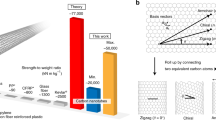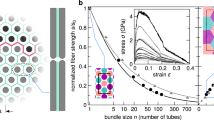Abstract
The rigorous size miniaturization of nanotechnology is continually generating new applications and new physical effects. We show here that nanotubes can be formed from thin solid films of almost any material at almost any position, once these films are released from their substrate. This exceptional design flexibility has useful implications, including for fluid transportation and capillarity on the nanometre scale, as well as offering the opportunity to extend fundamental investigations to a new diversity of materials, material systems and geometries.
Similar content being viewed by others
Main
There are two methods for making these solid-state nanotubes (Fig. 1a, b), involving a 'general' and a 'specialized' method. Both rely on the release of thin layers of the material from a substrate by a selective etching procedure. The position of the nanotubes is exactly determined by the etching time. Controlling the thickness of the layers and hence of the tube walls depends on the deposition method and can be as precise as a single atomic layer.
a, General method to create a nanotube (method I). An etchant-sensitive material is deposited on a substrate surface. On top of this sacrificial layer, a thin film (or a series of thin films) is deposited. After selective etching of the sacrificial layer, the thin top layer is wrapped up and folded back onto the sample surface, where it can bond to itself. At the position where the layer bends, a nanotube has formed. b, Specialized way to create a nanotube (method II). The layer sequence consists of an etchant-sensitive material, followed by a bilayer of two different materials (materials 1 and 2). Material 1 has a larger lattice constant than material 2, so a1 > a2. Once the bilayer is released by selective etching, each material tends to acquire its inherent lattice constant. The bilayer bends upwards, finally forming a nanotube after one complete revolution. Longer etching times result in multiple revolutions. c, d, Folded nanotubes fabricated according to method I. 'Epi' layer indicates epitaxial layer. e, SiGe-based nanotube formed along the edge of a sample (by method II).
A wide range of possible materials can be used for this technique — calling only for appropriate deposition, a selective etchant and a certain amount of elasticity in the nanotube material. For example, single crystalline nanotubes can be created from semiconductor materials, which can be grown in perfect single-crystal quality.
A typical silicon–germanium nanotube prepared by a 'general' method (Fig. 1a) is shown in Fig. 1c. The nanotube is 12 μm long and 230 nm in diameter, which yields an aspect ratio of 60. The single-wall thickness (16 nm) is precisely defined by our deposition technique. Smaller diameters can be achieved with thinner layers: for example, we used a 6-nm SiGe layer to create a nanotube with a minimum diameter of only 50 nm (Fig. 1d), a feat helped by the remarkable elasticity of this material. The tube formed exactly at the edge of the back-etched buffer layer, demonstrating the unprecedented control our method offers over the nanotube's position on the substrate surface.
We were also able to create SiGe nanotubes by using a 'specialized' method (Fig. 1b). A SiGe-based nanotube, which has formed along the edge of the sample, is shown in Fig. 1e. This nanotube is 20 μm long and has a diameter of 530 nm. It adopts the slight bend of the sample edge and its position is again precisely defined by the etching time. Nanotubes of indium, gallium and arsenic have also been created by this method1.
The variety of materials that can be engineered to produce solid-state nanotubes in this way, together with the precise control that can be exerted over their structure and position, make these nanotubes suitable candidates for use in fundamental investigations as well as in a range of applications. They could act as nanopipelines for fluid transportation and, as their diameter can be varied from nanometres to micrometres, they should be valuable in capillarity studies and in the design of syringe tips for nanoinjection, offering controlled generation of nanodroplets or nanobubbles in fluids or in fluid films on surfaces.
Nanotubes can act as nanodrillers, nanotweezers, microscopy tips, or as supporting rods in nanoobjects (if the wall is thick enough and the diameter small); if they have large diameters and thin walls, they can be used as nanocontainers or nanocapsules. Silicon-based compounds (SiC included) are particularly well suited for mechanical applications as this material is very hard and elastic.
Solid-state nanotubes could have electronic applications. Epitaxial growth (in which a layer of one material grows on a single crystal of another, so that the structure in the layer is the same as that in the substrate) can dope the grown layers in a precisely controlled manner over a concentration range of several powers of ten. Rolled-up nanotubes can serve as nanocables, or metal could be rolled into the nanotube or be made to fill it by capillary action. Possible roles in transistor design and in nanoelectronics have been proposed for carbon nanotubes2,3, so the availability of alternative materials should offer an increased flexibility in their design and properties.
References
Prinz, V. Y. et al. Physica E 6, 828–831 (2000).
Tans, S. J., Verschueren, A. R. M. & Dekker, C. Nature 393, 49–52 (1998).
Rueckes, T. et al. Science 289, 94–97 (2000).
Author information
Authors and Affiliations
Corresponding author
Rights and permissions
About this article
Cite this article
Schmidt, O., Eberl, K. Thin solid films roll up into nanotubes. Nature 410, 168 (2001). https://doi.org/10.1038/35065525
Issue Date:
DOI: https://doi.org/10.1038/35065525
This article is cited by
-
Self-assembly of Co/Pt stripes with current-induced domain wall motion towards 3D racetrack devices
Nature Communications (2024)
-
Nature-inspired micropatterns
Nature Reviews Methods Primers (2023)
-
Electronic materials with nanoscale curved geometries
Nature Electronics (2022)
-
Topological transitions in ac/dc-driven superconductor nanotubes
Scientific Reports (2022)
-
Inverse design of 3D reconfigurable curvilinear modular origami structures using geometric and topological reconstructions
Nature Communications (2022)
Comments
By submitting a comment you agree to abide by our Terms and Community Guidelines. If you find something abusive or that does not comply with our terms or guidelines please flag it as inappropriate.




